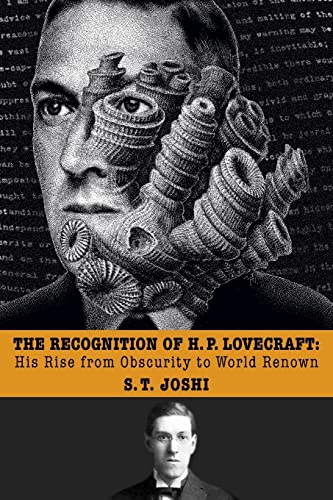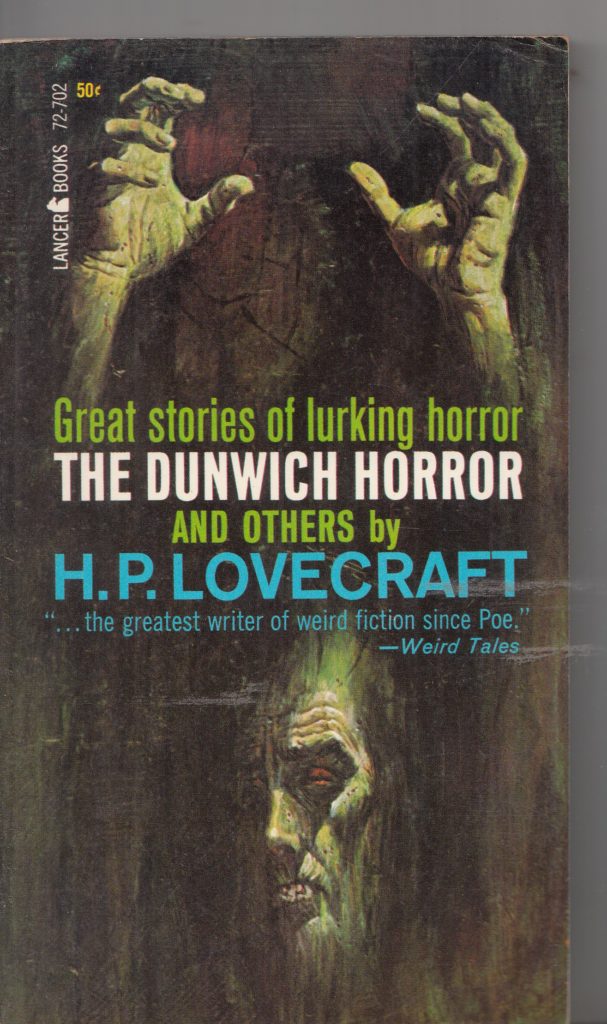
I first read H. P. Lovecraft in the early 1960s. Lancer Books published The Dunwich Horror and Others in 1963 and when I read it, I was hooked! Here’s the Table of Contents for that Lancer Books edition:
| Introduction: H.P. Lovecraft and his work / August Derleth | ||
| In the vault | ||
| Pickman’s model | ||
| The rats in the walls | ||
| The music of Erich Zann | ||
| The haunter of the dark | ||
| The Dunwich horror | ||
| The thing on the doorstep |

After that, I scoured used bookstores more more Lovecraft books. Lancer Books published THE COLOUR OUT OF SPACE and Others in 1967. Then, in the early 1970s, Ballantine Books started reprinting volumes of Lovecraft’s works.
Over the years, H. P. Lovecraft–who died in obscurity and poverty–steadily attracted new readers. Lovecraft pastiches proliferated. How did an unknown writer end up with a volume in the Library of America series? T. S. Joshi tracks the growth of Lovecraft’s recognition and status over the decades. If you’re interested in how a writer can go from zero to world renown, give The Recognition of H. P. Lovecraft a try. Are you an H. P. Lovecraft fan? GRADE: A
TABLE OF CONTENTS:
PREFACE –7
I. Beginnings (1905-1922) — 9
II. The Pulp Era (1923-1937) — 35
III. Arkham House: The Early Years (1937-1945) — 79
IV. The Beginnings of Worldwide Disseminaton (1946-1959) — 115
V. Paperbacks and Movies (1960-1971) — 139
VI. The revival of Scholarship (1971-1979) — 163
VII. Looking Toward the Centennial (1980-1990) — 199
VIII. The Road to Canonization (1991-2005) — 231
IX. Dissemination and Controversy (2006-2020) — 263
Epilogue — 311
Bibliography — 315
Index — 319
I had that edition as a teenager. I like some Lovecraft but in small doses. The only thing I have read of his in the last ten years has been his short novel At the Mountains of Madness which was better than I thought. I have read countless stories by other writers who have written Lovecratian tales. Caitlin Kiernan is one of the best.
Steve, you’re right about Caitlin Kiernan. Her Lovecraft pastiches are great! I also enjoy Charles Stross’s LAUNDRY series that include plenty of Lovecraftian elements.
Ah yes, I remember it well, reading that edition, loving Lovecraft and then tiring of him rather quickly.
Dan, Lovecraft encouraged his writer friends to write stories about the Mythos he created. That’s another factor that led to Lovecraft’s rise in critical judgement.
Joshi is the closest thing to a weird fiction scholar we have and definitely the guy to go to if you want to learn about the genre. I do find his writing clumsily idiosyncratic at times and he has a tendency to presume his opinions are gospel but he was taking this stuff seriously (and often had valid insights) long before anyone else.
My introduction to Lovecraft was when my mom took us kids to see THE DUNWICH HORROR at the drive-in, followed by the NIGHT GALLERY adaptations. I too then went through a Lovecraft phase in the mid-seventies when the Ballantine mass markets were hitting the drug store racks but I never became a fan. His work can be so damn murky I can only take him in small doses and often prefer his mythos through the eyes of other writers including the Derleth “collaborations” that, I think, have been unfairly maligned. Still, there is no arguing Lovecraft’s influence and this does look like an interesting read.
Byron, Joshi’s other books on Lovecraft analyze his works in more detail. This volume focuses on how Lovecraft’s fame grew over the decades. Joshi actually had a hand in promoting scholarly interest in Lovecraft.
Your critique of Joshi is closer to truth than your praise of him. Lovecraft himself was a much earlier scholar of horror, if an idiosyncratic one, and such predecessors and contemporaries of Joshi as Joanna Russ, Fritz Leiber, Dirk Mosig, Douglas Winter, E. F. Bleiler, Kim Newman and Les Daniels, and others often have contributed materials of more value and less overemphasis on personal reaction to the works under discussion.
Yes. That was a good collection. I read all the Lovecraft I could find ca. 1970 or ’71, even the poems! When we lived downtown, we weren’t fat from one of Lovecraft’s former residences during his time in Brooklyn. Of course, a lot of the uglier side of his personality came out over the years, but his best stuff is definitely worth reading (except for Rick)>
Jeff, like you I binged on Lovecraft early on in the Sixties and Seventies. Then, I discovered the Lovecraft pastiches and have been enjoying them ever since I started reading them. Yes, like most major writers, Lovecraft had a Dark Side.
Given that Lovecraft’s childish (and instilled in childhood) anti-Jewish spew was over by his last years (he did, after all, marry if not terribly successfully Sonia Greene who remained a friend after divorce, and mentor Robert Bloch), I have continued to wonder if he would’ve outgrown his other chauvinist nonsense if he’d lived longer and met more people of those other despised sorts. Alas, we can’t know.
My discovery of Lovecraft came in the late 50s (I was 15) with a collection called CRY HORROR that I found in a drugstore paperback rack. I loved it, but it was several years later that I found any more of his work. I recently stumbled across a documentary on Amazon Prime called LOVECRAFT: FEAR OF THE UNKNOWN. It’s a couple of years old, and I’d never heard of it, but it’s pretty interesting. It’s part biography and part discussion of his work. There are some impressive talking heads, S. T. Joshi among others. Also Ramsey Campbell, John Carpenter, Peter Straub, Neil Gaiman, Guillermo del Toro, and Caitlin R. Kiernan. It’s a must for any HPL fans who haven’t seen it.
Michael, thanks for the heads up on LOVECRAFT: FEAR OF THE UNKNOWN. I’ll check it out!
George, Lovecraft was not well-off at the time of his death (he was a master of financial self-sabotage, among other sorts), but obscure, much less unknown, is an overstatement, to say the least. He wasn’t quite the star of WEIRD TALES initially that Seabury Quinn was, but certainly close, and his work was being reprinted in notable volumes such as Dashiell Hammett’s CREEPS BY NIGHT in 1931, had published in such other magazines as ASTOUNDING and his Arkham House publication by Derleth and Wandrei, at a time when Derleth was Not an obscure figure in US letters, helped further his fame, as did the inclusion of two of his stories in Fraser and Wise’s perpetually in print GREAT TALES OF TERROR AND THE SUPERNATURAL from Random House/Modern Library in 1944, the same year’s publication of Derleth’s anthology SLEEP NO MORE from Farrar and Rinehart and its Armed Forces edition paperback (with three Lovecraft stories, though only “The Rats in the Walls” had his credit in the clear, the others were stories he’d “doctored”), the Armed Forces edition of his collection THE DUNWICH HORROR AND OTHER WEIRD TALES the next year having a considerably wider reach than the clumsily-packaged Bart House paperbacks of the same period, and generally his recognition among those who loved horror and related fields how influential he’d been, inside his group of corresponding friends (including of course Clark Ashton Smith, Robert Howard, and such acolytes who would quickly outstrip their mentor as Robert Bloch and Fritz Leiber) and certainly beyond.
That said, and as the last phrase might suggest, he’s not my favorite writer in the fields he loved, and there are others beyond Bloch and Leiber who took what they found most interesting in his example and did more and better with it (such as Ramsey Campbell and Fred Chappell, Thomas Ligotti and T. E. D. Klein, and such later yet writers as Kiernan). But I’m a fan of some of his work I’ve read…and think that Derleth’s horror fiction in his own voice remains superior to his attempts to remake Lovecraft into a Christian.
First encounter with HPL’s work was with “The Outsider” in Henry Mazzeo’s anthology (illustrated by Edward Gorey) HAUNTINGS. Took the 8yo me a minute to realize what polished glass was meant to suggest. Not my favorite story in the book, then or now.
https://socialistjazz.blogspot.com/2009/04/fridays-forgotten-books-hauntings.html
https://socialistjazz.blogspot.com/2017/04/robert-bloch-in-some-of-his-best.html
Todd, I imagine many of the commentators of this blog can remember their first experience with a Lovecraft story!
Todd, like many others I find Lovecraft’s writing style problematic. But, what I do admire is Lovecraft’s Mythos of strange, menacing aliens mostly unknown to humanity. Leiber and Bloch certainly wrote stories using Lovecraft’s Old Ones and Elder Gods. My favorite early Lovecraft pastiche is Frank Belknap Long’s “The Hounds of Tindalos.”
And, what’s more important, they found their own versions of what could make those entities so terrifying. For Bloch, largely what we could do to each other and ourselves; for Leiber, the ways we could help create our new monstrosities, whether supernatural or all too possible among humans and our societies.
Todd, well said!
First encounter with HPL’s work was with “The Outsider” in Henry Mazzeo’s anthology (illustrated by Edward Gorey) HAUNTINGS. Took the 8yo me a minute to realize what polished glass was meant to suggest. Not my favorite story in the book, then or now.
https://socialistjazz.blogspot.com/2009/04/fridays-forgotten-books-hauntings.html
How does Joshi handle the last chapter of his book? Does he treat the controversies mentioned in the title dispassionately and professionally, or does he attack the people he disagrees with?
Jeff, Joshi does a little bit of both. He has to admit Lovecraft’s problems–there’s plenty of documentation of those–but he does get snarky about Ellen Datlow getting the Lovecraft statute banned from the World Fantasy Convention.